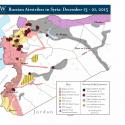 |
 |
Russian Airstrikes in Syria: December 13 - 21, 2015

Russia continues to use its air campaign in Syria to bolster the position of Syrian President Bashar al-Assad despite an ongoing political process to end the Syrian Civil War. Russian warplanes concentrated airstrikes against rebel positions southwest of Aleppo City from December 18 to December 21, enabling pro-regime forces to seize the key town of Khan Touman and several nearby villages on December 20. Russian airstrikes later shifted to target rebel forces along the strategic M5 Highway to Aleppo City in likely preparation for future offensive operations. Russia also continued to indiscriminately target rebel-held terrain throughout Northwestern Syria and Damascus in an effort to bolster ongoing regime offensives and weaken the resolve of the opposition. Russia conducted only a limited number of airstrikes against ISIS targets in Aleppo and Homs Provinces over the reporting period.
Russia remains willing to conduct its air campaign in Syria without regard to civilian casualties or international law. Russian warplanes targeted residential neighborhoods in rebel-held Idlib City on December 20, killing or wounding over two hundred civilians. The heavy bombardment sparked renewed clashes near the besieged pro-regime enclaves of Fu’ah and Kefraya northeast of Idlib City, threatening to overturn a UN-sponsored local ceasefire that also includes the besieged rebel-held town of Zabadani near Damascus. Russia also targeted a relief organization and food distribution center in the besieged Eastern Ghouta suburbs of Damascus on December 20, demonstrating calculated intent to target critical civilian infrastructure as a tactic of war. Meanwhile, Russia reportedly began dropping PFM-1 ‘Green Parrot’ cluster mines in Syria in a new demonstration of disregard for international norms. ‘Green Parrot’ mines generated high levels of child casualties during the Soviet War in Afghanistan due to their bright colors and harmless ‘toy-like’ appearance. Nonetheless, Russian President Vladimir Putin insisted that Russia could use even more of its military capabilities if necessary in order to achieve its goals in Syria.
The following graphic depicts ISW’s assessment of Russian airstrike and cruise missile locations based on reports from local Syrian activist networks, Syrian state-run media, and statements by Russian and Western officials. This map represents locations targeted by Russia’s air campaign, rather than the number of individual strikes or sorties.
High-Confidence reporting. ISW places high confidence in reports corroborated both by official government statements reported through credible channels and documentation from rebel factions or activist networks on the ground in Syria deemed to be credible.
Low-Confidence reporting. ISW places low confidence in secondary sources that have not been confirmed or sources deemed likely to contain disinformation.